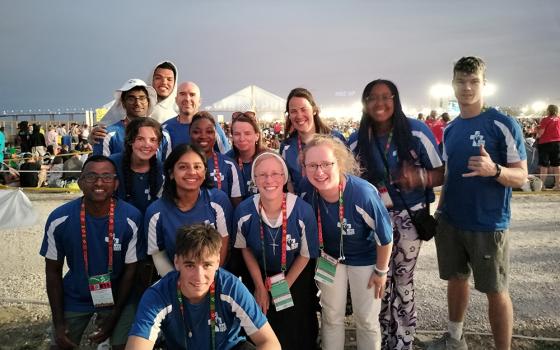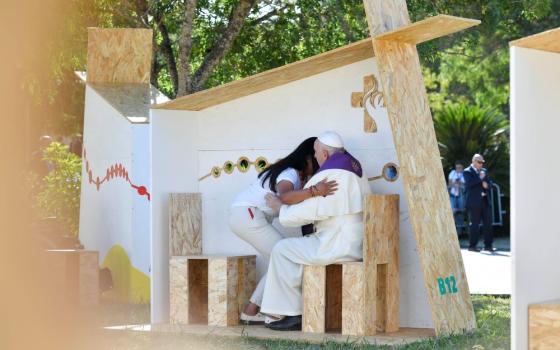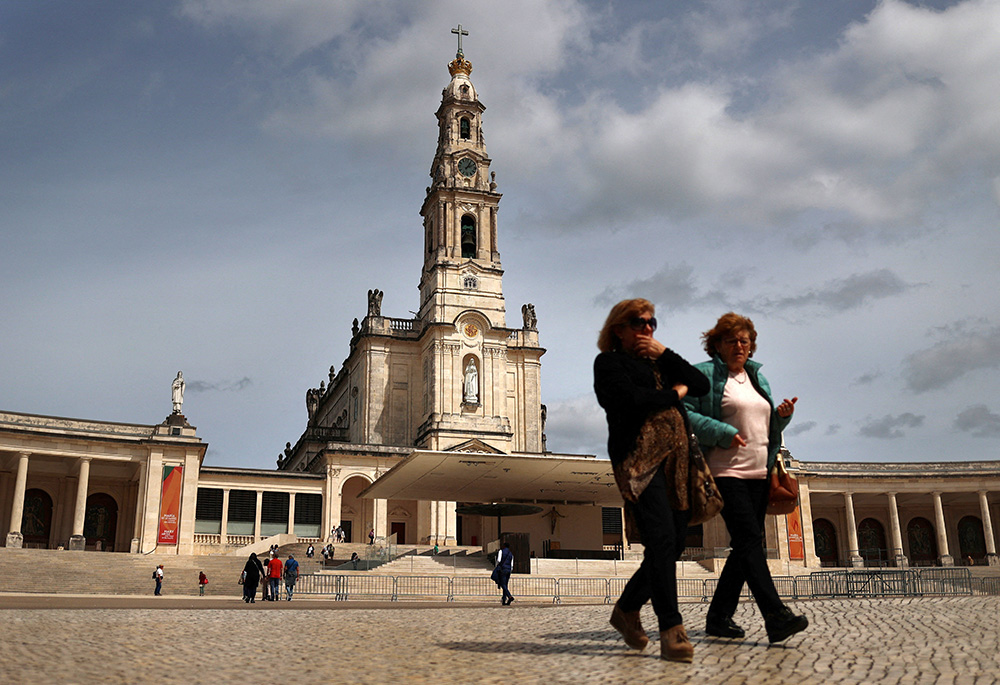
Women walk at the Marian shrine of Fátima in central Portugal March 30. (OSV News/Reuters/Pedro Nunes)
For decades, a popular expression in Portugal has referred to the country's "three F's."
Futebol. Fado. Fátima.
Futebol, or soccer, and fado, a folk musical genre with cross-generational appeal, are as popular as ever in Portugal. And more than 100 years after the reported events at the Cova da Iria, Fátima remains a distinct feature of Portuguese culture and Catholicism. For this reason, it seemed inevitable that a stop at the ever-popular Marian shrine would be a part of Pope Francis' five-day visit to the country this week for World Youth Day festivities.
Millions of pilgrims travel to Fátima every year, where it is said that the Virgin Mary appeared to three shepherd children over the course of six months in 1917, culminating with the Miracle of the Sun, a solar phenomenon reportedly witnessed by an estimated 70,000 people.
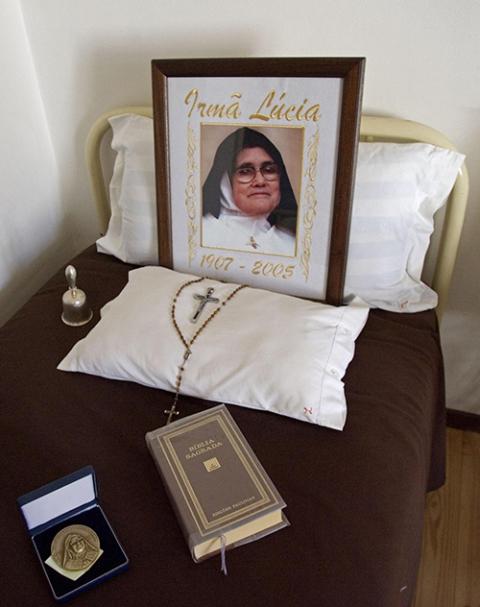
A portrait of Sr. Lúcia dos Santos, her Bible and her rosary lie on her bed in the Carmelite cloister in Coimbra, Portugal, in 2006. Dos Santos, who died in 2005, was declared "venerable" on June 22, 2023, by Pope Francis. (OSV News/Reuters)
From those reported apparitions and the later writings of Carmelite Sr. Lúcia dos Santos — the only "pastorinho" who lived to adulthood — Fátima over the decades has been intertwined with anti-communist sentiment, an emphasis on personal piety and penance for sin, intermittent tensions between the hierarchy and popular religiosity, prophecies of wars, as well as apocalyptic spirituality and related conspiracy theories of suppressed secret private revelations.
While Popes John Paul II, Benedict XVI and Francis have all shown a devotion to Fátima, so have QAnon conspiracy theorists and figures such as disgraced Archbishop Carlo Maria Viganò — making the message and meaning of Fátima sometimes difficult to decipher.
"Fátima is unusual among Marian apparitions because it brings together an intriguing combination of ingredients: mystical experiences, global politics and internal church tensions," veteran Vatican observer John Thavis told NCR via email. "That provides fertile ground for imaginative interpretation."
"The secrets of Fátima have long prompted speculation, and the Vatican has at times tried to rein in conspiracy theories and doomsday scenarios associated with these messages," said Thavis, who is author of The Vatican Prophecies.
When Francis first visited Fátima in 2017 — to mark the centenary of the apparitions — he pleaded for an end to a culture of conflict, as he recalled that when Mary first appeared there, it was to call for peace in the midst of the First World War.
With war raging again in Europe, Francis will undoubtedly redouble his efforts to call for an end to Russia's invasion of Ukraine — though it may not be without controversy and could fuel even further conspiracies.
Soon after the outbreak of the war, at the request of the bishops from Ukraine, Francis consecrated both Russia and Ukraine to the Immaculate Heart of Mary. The event was steeped in history.
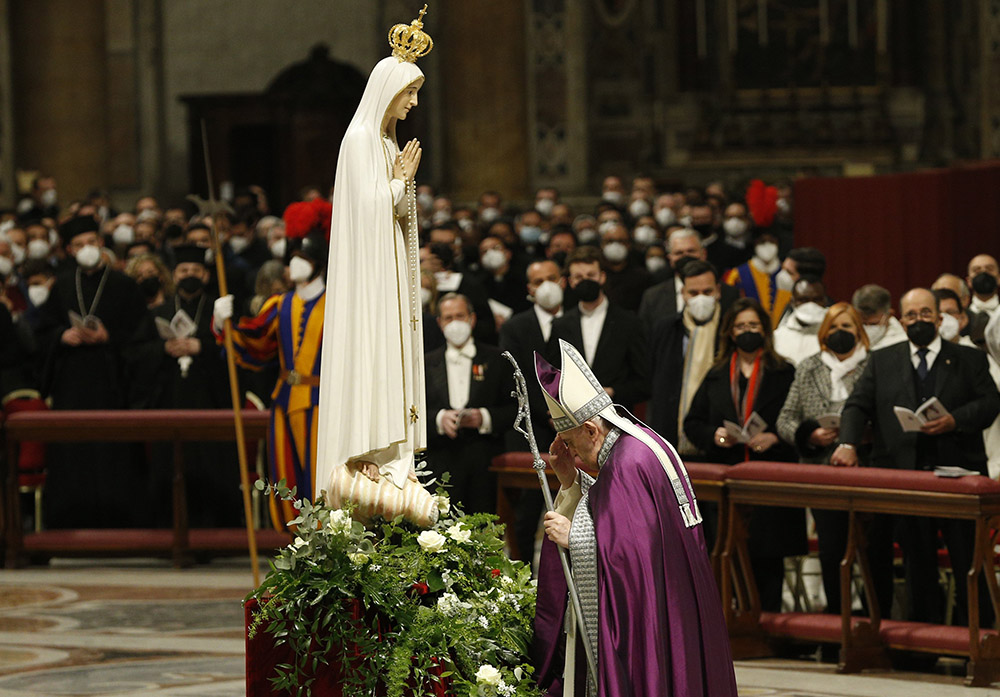
Pope Francis makes the sign of the cross in front of a Marian statue after consecrating the world and, in particular, Ukraine and Russia to the Immaculate Heart of Mary during a Lenten penance service in St. Peter's Basilica at the Vatican March 25, 2022. (CNS/Paul Haring)
In 1941, dos Santos wrote a full account of the "secrets" Mary gave at Fátima — including a vision of hell with a plea that Russia be consecrated in the name of her Immaculate Heart so that the atheistic, communist regime may be converted.
According to Thavis, the Fátima request to consecrate Russia to Mary has proven problematic.
"Pope John Paul II did so more than once, but critics complained that these rituals were too generic and lacked a direct appeal for Russia to 'convert,' " he said. "Pope Francis last year held a similar ceremony to consecrate Russia, Ukraine and all humanity to Mary. Predictably, this, too, was deemed too broad by some Fátima devotees."
"Aside from these technical objections," Thavis added, "I think Fátima conspiracy theorists are motivated by a distrust of the general direction of the post-Vatican II church, including the progressive policies of Pope Francis."
Franciscan Fr. Stefano Cecchin, president of the Pontifical International Marian Academy, told NCR that there have been "various manipulations" of the Fátima messages, many of which have been targeted at the pope.
"Unfortunately, today there are groups who define themselves as Catholics, but who love to look for everything that can condemn the pope," he said.
Cecchin believes that the pope's motivation to return to Fátima in this moment is straightforward: to pray for peace.
Advertisement
"The pope is aware that the world is in danger of self-destruction with a nuclear conflict," he said. "Only by praying to the Virgin can a path to peace be found."
While that may sound apocalyptic — as many Fátima-related messages do — Cecchin said that Fátima is ultimately a message of hope and of triumph over evil.
And for many Portuguese Catholics, that also helps explain the long-lasting appeal of Fátima, even among ordinary people who do not regularly practice the faith.
"Almost all Portuguese people have already been to Fátima, which they visit frequently to pray. I often ask what the church and even Portugal would be like as a country without Fátima," said Fr. Anselmo Borges, a member of the Missionary Society of the Good News and a philosophy professor at the University of Coimbra in Portugal.
While some conservative Catholics, especially in the Anglophone world, see Our Lady of Fátima through an eschatological lens, Borges told NCR that the Portuguese nation sees her as being connected to a God of consolation.
Maria Conceição Mendes, who lives in the island of Corvo in the Azores, told NCR that she visited Fátima in November 2019 after having had spinal surgery.
"I asked her for help when I left here to have an operation and she granted me the grace to be at peace at the time," Mendes said.
But when Francis returns to Fátima on Aug. 5, there will undoubtedly be more debates and controversies, but that simple message of peace will likely be his focus, as well.





